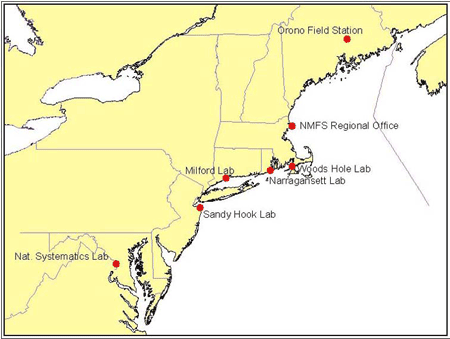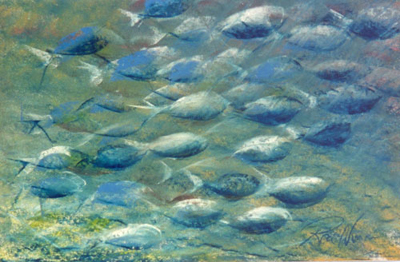Fisheries Historical Page
- Welcome
- Ships
- Photos
- Historical Articles
- NOAA History
- NEFSC
- Fish FAQ

This is where it all started, right here
in Woods Hole, Massachusetts
We Have Been Conserving America's Living Oceans Since 1871
- The Nation's first Federal conservation agency, initiated in 1871, was devoted to the protection, study, management, and restoration of fish.
- This agency was the United States Commission of Fish and Fisheries, which was usually just called the Fish Commission.
- Later it was renamed the Bureau of Fisheries, and still later it became the Bureau of Commercial Fisheries.
- Today its direct descendant is NOAA's National Marine Fisheries Service, now known as NOAA Fisheries.
Woods Hole as a center of marine science was conceived and developed largely by one man, Spencer Fullerton Baird, Assistant Secretary of the Smithsonian at the time. He was appointed by President Ulysses S. Grant in 1871 as the first US Commissioner of Fisheries.
Fisheries research began in Woods Hole as early as 1871, but a permanent station did not exist until 1885.
Be sure to take a tour of the historical timeline at the top of the page to learn more.

Since its beginning in 1871, the Fisheries has had many research vessels that sailed out of Woods Hole. From 1880 and the Fish Hawk which was the first floating marine hatchery, to the Henry B. Bigelow and the Gloria Michele which sail today.

Albatross I. Artwork by Janet Ward - NOAA
Historic Vessels
- Fish Hawk was an ocean-going marine fish hatchery outfitted for general scientific research. It sailed out of Woods Hole for 46 years from 1880 - 1926.
- Grampus was a schooner built for fisheries research. This boat's design was revolutionary and it changed the way fishing schooners were built. Legend has it that Grampus was the model for Rudyard Kipling's schooner in Captain's Courageous. She was commissioned in 1886.
- Albatross I 1882/83 work on the first research vessel ever constructed exclusively for fisheries research is started, the Albatross, is commissioned and the vessel is finished.
- Albatross II 1926: The Bureau's steamer Fish Hawk is relinquished. Shortly after, the Bureau obtains the ocean tug Patuxent from the Navy. It is renamed the Albatross II and outfitted for research use.
- Phalarope was a small coal burning steamer used for day long collecting trips around the waters of Woods Hole in the 1930s.
- Albatross III, originally named the Harvard, was built in 1926 as a steam trawler and fished New England waters until 1939 when she was sold by the General Seafoods Corporation to the Government for $1.00 to be converted into a fisheries research vessel.
- Albatross IV was built in 1962, by the Southern Shipbuilding Corporation of Slidell, Louisiana. The Albatross IV was designed to meet the operational requirements developed by the staff at the Bureau of Commercial Fisheries (now National Marine Fisheries Service) biological lab at Woods Hole, Massachusetts.
- Delaware II conducted fishery and living marine resource research in support of NOAA's National Marine Fisheries Service (NMFS), Northeast Fisheries Science Center's Woods Hole Laboratory in Woods Hole, MA. The ship's normal operating area was the Gulf of Maine, Georges Bank, and the continental shelf and slope from Southern New England to Cape Hatteras, NC.
Current NEFSC Research Vessels
- Henry B. Bigelow NOAA Ship Henry B. Bigelow was launched at VT Halter Marine, in Pascagoula, Mississippi on July 8, 2005. Henry B. Bigelow is the second of four new fisheries survey ships to be built by NOAA. The ship is one of the most technologically advanced fisheries survey vessels in the world. The ship conducts fishery and living marine resource research in support of NOAA's National Marine Fisheries Service (NMFS), Northeast Fisheries Science Center's Woods Hole Laboratory in Woods Hole, MA.
- Gloria Michelle Fisheries Research Stern Trawler based at the Woods Hole lab.


NEFSC Historical Photos Archive
The NEFSC Woods Hole Laboratory's Information Services Section houses a collection of historical photographs which provide a visual description of the U.S. Fish Commission, starting when the lab was first founded in 1871 in Woods Hole and continuing through to present time.
The photos are mostly of New England fisheries scenes. Photographs are being scanned and added constantly so check back often.
NEW SITE AVAILABLE - CLICK HERE!
NOAA Photo Collection
NOAA Central Library has thousands of historical photos from the weather service, Fisheries, Geological Survey and much more. These photos date back over 100 years. A must see!

The formation of the Fisheries had a hard time passing the Congress in 1871. Here is a brief history of NMFS, "A Century of Conservation".
Forty-First Congress. Sess. III. 1871: "Whereas it is asserted that the most valuable food fishes of the coast and the lakes of the United States are rapidly diminishing in number, to the public injury, and so as materially to affect the interests of trade and commerce..."
Visit the Classics section of our publications office
Spencer Baird's Legacy Which started in Woods Hole spans over 125 years of Fisheries research.
The National Marine Fisheries Service started in 1871 here in Woods Hole. This quick history of Woods Hole and the early days of the Fisheries starts long before then when in 1602 Bartholomew Gosnold first landed here...
History and Contributions of the Woods Hole Fisheries Laboratory was taken from a lecture given at the Fisheries Centennial Celebration (1985) by Robert L. Edwards. It gives an overview of the historical contributions the Woods Hole fisheries lab made to the formation of fisheries science and the beginnings of the scientific community in Woods Hole.
Historical Development of Fisheries science was taken from a lecture given at the Fisheries Centennial Celebration (1985) by William F. Royce and is his review of the development of fishery science and management.
Groundfishing, the catching of fishes that swim in close proximity to the bottom, was the first colonial industry in America. Now we are faced with unprecedented low stocks of groundfish species, and an industry shrinking in regional importance. This Brief history of groundfishing in New England is intended to look back to the beginnings of the 20th century, and to follow the development of groundfishing to the current times.
Smithsonian's National Museum of Natural History articles on Spencer Baird -- The year 2000 marked the 150th anniversary of ichthyology at the Smithsonian Institution. In 1850, a young naturalist named Spencer F. Baird arrived at the Smithsonian to take up his duties as the new Assistant Secretary. Over the next 37 years, while occupying the posts of Assistant Secretary and then Secretary of the Smithsonian, Director of the United States National Museum, and Commissioner of Fish and Fisheries, Baird, among his many other accomplishments, oversaw the establishment and development of ichthyology as a vital component of the institution's scientific mission.

This 1948 report, by William F. Royce, describes in lay language the first year of operation of the ALBATROSS III
Online version of the 1953 edition of Bigelow and Schroeder's "Fishes of the Gulf of Maine"
Report upon the Invertebrate Animals of Vineyard Sound and the Adjacent Waters, with an Account of the Physical Characters of the Region," Report of United States Commissioner of Fisheries 1874.

NOAA History is an intrinsic part of the history of the United States and the development of its science and commercial infrastructure.
The ancestor agencies of the National Oceanic and Atmospheric Administration include the United States Coast Survey established in 1807, the United States Weather Bureau established in 1870, and the United States Commission of Fish and Fisheries established in 1871.
The NOAA History page has it all... one fantastic website!


The Northeast Fisheries Science Center is the research arm of NOAA Fisheries in the region. The Center plans, develops, and manages a multidisciplinary program of basic and applied research to: (1) better understand living marine resources of the Northeast Continental Shelf Ecosystem from the Gulf of Maine to Cape Hatteras, and the habitat quality essential for their existence and continued productivity; and (2) describe and provide to management, industry, and the public, options for the conservation and utilization of living marine resources, and for the restoration and maintenance of marine environmental quality.

The functions are carried out through the coordinated efforts of research facilities located in Massachusetts, Rhode Island, Connecticut, New Jersey, and Washington, DC.
The James J. Howard Marine Sciences Laboratory,located on the New Jersey shore at Sandy Hook, is a state-of-the-art marine research facility shared by the National Oceanic and Atmospheric Administration (NOAA) and the State of New Jersey. Federal research at the laboratory is conducted by NOAA's National Marine Fisheries Service (NMFS).
The primary mission of the Howard Laboratory is to conduct research in ecology, leading to a better understanding of both coastal and estuarine organisms and the effects of human activities on nearshore marine populations.
The Milford CT Laboratory, established in 1931, is located on the shore of Long Island Sound. The facility is comprised of two laboratory/office buildings and support buildings housing raceway and circular tanks. A 49-foot vessel, the R/V Victor Loosanoff, is also docked at the Laboratory for nearshore research.
Present research emphasizes aquaculture and habitat-related work. A well-integrated aquaculture program includes studies of the culture of fish and shellfish to develop methods suitable for commercial use as well as for stock enhancement and restoration. Nearshore habitats are being studied to determine what characteristics make a habitat suitable for a particular species.
The Narragansett RI Laboratoryis located on three acres of federally owned land on the Bay Campus of the University of Rhode Island (URI). It is adjacent to URI's Graduate School of Oceanography and the National Health and Environmental Effects Research Laboratory of the Environmental Protection Agency (EPA). The facility consists of one main building and aquarium, and four adjacent office/laboratory modular buildings. The laboratory is a facility with a specialized staff of 50 supported by advanced oceanographic and biological systems for carrying out research on the effects of changing environmental conditions on the growth and survival of fish stocks from an ecosystems perspective.
Research is conducted on the effects of changing oceanographic and ecological conditions on the productivity and health of the Northeast U.S. Continental Shelf ecosystem in relation to the recovery of depleted fish stocks. Studies are also conducted on the demography and ecology of shark populations in response to oceanographic conditions to provide information for shark management plans for sustaining those populations. The studies are conducted in support of two major objectives of NOAA's Strategic Plan - Build Sustainable Fisheries and Sustain Healthy Coasts.
The Orono ME Field Station is the NEFSC salmon research field station.
The Woods Hole MA Laboratory occupies 3.4 acres on Vineyard Sound. The facility houses both the Woods Hole Laboratory Research Divisions and the Northeast Fisheries Science Center Directorate. The Center provides overall management and direction for the five laboratories located in the Northeast Region.
In addition, the Operations, Management, and Information Division and Data Management Systems Staff are located at the Woods Hole Laboratory. The Laboratory houses a public and research aquarium that is open to visitors year round and also utilizes several research vessels, R/V Gloria Michelle, R/V Henry B. Bigelow and R/V Delaware II.


Artwork is Copyrighted and used by permission of the artist Rea Nurmi
The Fish FAQ - NMFS annually answers thousands of questions about the oceans and the life that thrives within them. On the basis of a canvass of experienced marine scientists in the Fisheries Service done in 1973, more than a hundred questions have been chosen as most representative. These are the Most Frequently Asked Questions containing some fascinating facts about fish.


